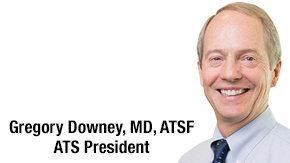“At any given moment, public opinion is a chaos of superstition, misinformation, and prejudice.” – Gore Vidal

Superimposed on the COVID-19 pandemic, there was a different type of pandemic sweeping the world - the purposeful spreading of medical misinformation. Sadly, this scourge is not new. Misinformation, superstition, and outright lies have plagued the practice of medicine from its very inception. Misinformation comes in many forms: crackpot theories, superstition, or pseudoscience. Among the most dangerous sources of misinformation, however, is that which is politically or financially motivated. Unscrupulous individuals including politicians and “snake-oil salesmen” seek to further their own political agenda off the fear, misery, and illness of others. Dishearteningly, this latter category includes health care professionals including MDs, DOs, and RNs.
The ATS has been fighting the battle against medical misinformation for years. In 2017, the Society led a rally in Washington, DC advocating for truthfulness in scientific and medical information. Today, our efforts and commitment to scientific truths must be redoubled. Misinformation must be recognized and treated as the public health crisis that it is.
Throughout the pandemic we have felt helpless, angry, and hopeless as we watched many of our patients make health care decisions based on incomplete or incorrect information obtained via social media often leading them to forgo lifesaving precautions (for example, masks, social distancing) and therapies (COVID-19 vaccinations) and instead turn to unproven or harmful ones (such as ivermectin and hydroxychloroquine). Their decisions were contrary to scientifically and medically proven facts. We helplessly watched as their clouded judgment resulted in their own, often preventable, serious illnesses, and deaths.
At this juncture, many questions arise including: what is our responsibility in protecting science? How can we better educate the public? How can we fight back against medical misinformation? Is medical misinformation widening health disparities throughout our communities? What should our strategy be?
First and foremost, we must identify where misinformation originates, and where we can begin to fight it.
Social Media
To fight against the misinformation and lies perpetuated by social media, I would be in favor of creating a new federal office of social media oversight. This would need to be a non-political and science-led office that would work in concert with existing agencies such as the FDA, NIH, and CDC, along with professional organizations such as the ATS, to identify and call out misinformation and its promoters. The creation of such an agency would need to be done thoughtfully and monitored closely for unintended consequences to ensure that well-intentioned health care providers are not inadvertently defamed recognizing the incredibly nuanced nature of medical decision making. Such an agency would also need to be kept free of political interference based on lessons learned from other federal agencies that have been subject to political pressure to the detriment of the best science and public health.
Notwithstanding, social media companies should be held accountable for what is posted on their platforms and should face liability similar to broadcast media’s “truth in advertising” statutes. This is an area where the Federal Trade Commission should have input.
Despite the challenges, it is important to keep in mind that not all is dire and there are rays of sunshine penetrating the clouds of misinformation; an unexpected outcome of the pandemic is that governments and social media platforms have found some common ground. Platforms like Facebook, Twitter, and YouTube have realized that they do not want to accept the moral (as well as possible legal and financial) responsibility for harm caused by misinformation. In the past, industry self-policing has proven ineffective, but a hybrid of government and private industry working together represents a possible step forward.
In our daily lives one thing we can all do is to report misinformation directly to social media platforms. When we encounter these lies during our daily lives it is critical to report them immediately before they can be further amplified. One person cannot fight this battle, but as a community, we can begin to make a difference.
Patient Facing
When speaking with our patients, I think that is important for us to try to understand, respect, and empathize with their beliefs and perspectives even if we do not agree with them. Patience is paramount and we should of course avoid being argumentative, confrontational, or condescending. In my experience, listening to and empathizing with our patients will help them appreciate and trust our perspective. A lot of the perceived and actual disparities in our health care system stem from the patient’s belief that their medical professional does not listen to or dismisses their beliefs and concerns. We can overcome this by being prepared to offer our patients a list of trustworthy resources, links, articles, and videos that outline the scientific and clinical facts in a clear and unbiased way. Another suggestion is to give our patients some “homework”– why not, they Google everything else! Here it is critically important to steer them to the right sites to visit and let them find the most reliable and clearly explained information.
In the coming months leading up to the ATS Annual International Conference in May 2023 in Washington, DC, let us continue the conversation on what more we can do to fight misinformation. Collectively, let us develop a strategy to fight misinformation and prevent its proliferation.

